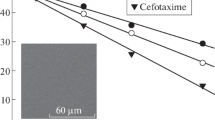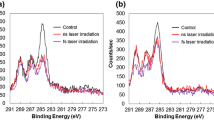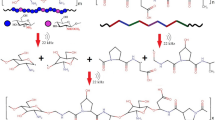Abstract
Various poly(lactic-co-glycolic acid)-based polymeric films with various molecular weights were obtained. The mechanical characteristics of these films were investigated. It was shown that the obtained polymer films do not have a short-term toxic effect on mammalian cells. The percentage of actively dividing cells on such polymer films is 1.5–3.0 times higher than when grown on culture glass, and, accordingly, the cell layer is formed faster. The obtained poly(lactic-co-glycolic acid)-based polymer films are biocompatible.
Similar content being viewed by others
Explore related subjects
Discover the latest articles, news and stories from top researchers in related subjects.Avoid common mistakes on your manuscript.
INTRODUCTION
The creation of biocompatible and atraumatic systems capable of long-term and controlled release of pharmaceuticals is one of the most promising and rapidly developing areas of chemical technology [1]. Materials capable of delivering medicinal substances are mainly used to cover surgical implants or as dressings; they are often based on biodegradable polymer films and/or fibers. The main competitive advantage of systems with controlled release of pharmaceutical products is the ability to maintain a near-stationary level of a pharmaceutical product in a tissue or biological fluid for the time required for therapy, which is often long [2]. The operation of systems with controlled release of pharmaceuticals is determined by the properties of the materials used for the manufacture of these systems, namely, the physicochemical properties of the base and therapeutically active and auxiliary substances [3, 4]. In general, systems of controlled delivery of pharmaceuticals, in addition to the required physicochemical and mechanical properties (high sorption capacity, elasticity, gas permeability, stability, etc.), should be atraumatic, biodegradable, and biocompatible. Poly(lactic-co-glycolic acid) is a promising material for the production of systems with controlled release of pharmaceuticals [5, 6].
Poly(lactic-co-glycolic acid) is a copolymer of glycolic acid (glycolide) esters and lactic acid (D,L-lactide) (Fig. 1). Glycolide and lactide monomers are synthesized by dimerization of glycolic and lactic acids. Poly(lactic-co-glycolic acid) is obtained by polymerization of these dimers (ring-opening polymerization) [7, 8]. By varying the ratio of copolymers, one can obtain poly(lactic-co-glycolic acid) polymers with various desired physicochemical and biomechanical characteristics; all poly(lactic-co-glycolic acid) species are biodegradable and thermoplastic [9, 10]. An obvious advantage is that poly(lactic-co-glycolic acid) is produced by using renewable plant resources as raw materials. Some poly(lactic-co-glycolic acid) polymers are already used in medicine for the manufacture of hydrogels, surgical filaments, and processing pins [11, 12]. Poly(lactic-co-glycolic acid)-based polymers can certainly be used to create medicinal forms that enter the body through mucous membranes [13], as well as in encapsulation technologies [14], sorption [15], targeted therapy [16], etc.
This paper investigates mechanical properties and biocompatibility of the poly(lactic-co-glycolic acid)-based polymer films obtained.
MATERIALS AND METHODS
For the manufacture of polymer films, poly(glycolide-D, L-lactide) (OOO MEDIN-N, Russia) was used: the stoichiometric ratio was 30/70; the molecular weight of polymers was about 45, 90, or 180 kDa. Weighed polymer samples were dissolved in chloroform at a temperature of 80°C to final concentrations of 1, 3, or 5%. The resulting solutions, without changing the temperature for 1 h, were stirred using an overhead stirrer until complete dissolution and poured into glass pallet forms. Drying was carried out for 48 h at 37°C. Model polymer films were removed from the pallet forms.
The mechanical properties were studied using an INSTRON 3382 universal testing machine at the rate of 10 mm/min. Testing of polymer films with the determination of the relative elongation, yield strength, and tensile strength was carried out according to GOST 14236-81. Processing of test results in determining the characteristics of mechanical properties was carried out using INSTRON Bluehill 2.0 software. The measurement error of the testing machine was 0.5%.
In this work, we employed a cell culture of human neuroblastoma SH-SY5Y. Cells of this culture usually grow in two ways: that is why they are used in the study of cell differentiation. Differentiation changes the function of the cell, its size, shape, and metabolic activity. Some of the cells of the SH-SY5Y line grow into clusters of cells that float in media, while others form clumps that root on substrates. SH-SY5Y cells can spontaneously interconvert between the two phenotypes in vitro: neuroblast-like cells and epithelial-like cells.
Cultivation cells were sown on Petri dishes 35 mm in diameter at the rate of 104 cells/cm2, in a volume of 3 mL per dish. The cultivation medium was DMEM + 10% FBS (fetal bovine serum) + 30 μg/mL gentamicin [17]. Before cultivation, the studied polymer films were sterilized using gamma radiation at the power of 20 Gy/min; the absorbed dose was about 16.8 kGy. After that, under sterile conditions, the materials were laid on the bottom of Petri dishes and mechanically fixed. As a control, round cover glasses for cell culture were used.
Analysis of mitotic activity was carried out using fluorescence microscopy through in vivo staining with the Hoechst 33342 fluorescent nuclear dye (Sigma-Aldrich, United States). Mitotic cells were detected by chromatin distribution characteristic of prophase, metaphase, anaphase, and telophase. At least 500 cells were counted for analysis. The mitotic index (MI) was calculated by the formula MI = (P + M + A + T)/N × 100%, where (P + M + A + T) is the sum of cells at the prophase, metaphase, anaphase, and telophase stages, and N is the total number of cells analyzed [18].
A cytotoxic test—determination of the number of living and dead cells—was carried out by staining the cells growing on the surface of the samples with the fluorescence dyes Hoechst 33342 (2 μg/mL) and Propidium Iodide (2 μg/mL) [19]. Then the samples were incubated for 10 min in the medium HBSS + 10 mM HEPES (pH 7.3) at 37°C. After staining, the cells were washed. Fluorescence imaging was carried using an image system based on Leica DMI6000 B and Tri light filter kits (Leica Microsystems) sequentially in the blue and red channels. At least 500 cells were counted for analysis. Counting of live and dead cells was carried out after 96 h of cultivation.
RESULTS AND DISCUSSION
Table 1 shows the average results of mechanical testing of polymer films based on poly(lactic-co-glycolic acid) with various molecular weights and concentrations when dissolved in chloroform. It is shown that the thickness of the films, their plasticity, and strength are directly related to the molecular weight and concentration. Increasing the concentration of the polymer in the solution leads to an increase in the thickness of the polymer layer and plasticity, but reduces the strength of the polymer film. An increase in the molecular weight of poly(lactic-co-glycolic acid) leads to a decrease in the thickness of the polymer film and an increase in plasticity. The observed trends are confirmed by previously published results [20].
To determine the number of living and dead cells, cells growing on the surface of the samples were stained with fluorescent dyes. Typical photographs of SH-SY5Y neuroblastoma cells stained with Hoechst 33342 and Propidium Iodide after three days of culture are shown in Fig. 2. The dye Hoechst 33342 is able to penetrate into living cells and stain them. In contrast, the dye Propidium Iodide is almost unable to penetrate into living cells and stain them. Over a short incubation time (about 10 min), it stains only cells with a damaged plasma membrane. A plasma membrane with gaps through which the dye penetrates is one of the main signs that the cell is dead.
Data on the effect of films on cell viability are presented in Table 2. All the samples of the surfaces of the materials used in the work did not differ from the control samples (glass) and did not have a statistically significant toxic effect on the cells growing on these surfaces for three days. From the data obtained, it follows that an increase in the sample thickness leads to a decrease in the number of dead cells. Thus, all the samples of the surfaces of the materials used in the work did not have a short-term toxic effect on the cells growing on these surfaces de novo.
The mitotic index is an indicator reflecting the percentage of dividing cells from the total amount of cells analyzed. It characterizes the intensity of division by the presence of cells in the growth phase (dividing cells); the higher its value, the more intense the process of cell division and vice versa. The proliferative activity of cells on the surface of the studied samples is presented in Table 3. It was shown that the proliferative activity of cells when grown on glass is approximately 1.5%. On all types of polymer films, the mitotic index is higher. The minimum mitotic index on films is 1.5 times higher than when grown on culture glass. On average, for all the types of films tested, the mitotic index is about 3.0, which is about 2 times higher than when growing cells on glass. The maximum mitotic index on films is 2.4 times higher compared to cultivation on glass. From the data obtained, it follows that an increase in the thickness of the sample leads to an increase in the mitotic index.
A morphological analysis of cells on the surface of the materials was carried out after three days of cultivation (Table 4). It was shown that the surfaces of the studied samples are suitable for attachment and spreading of cells. After three days of cultivation, on the surface of all samples, cells do not form a fused monolayer but only its individual elements. No inseparable monolayer is formed on the surface of the glass sample; the cells occupy about 65% of the surface available for growth. On average, on all the samples studied, cells occupy about 70–80% of the surface available for growth, but on these films, in addition to the formation of a monolayer, the formation of a multilayer cell culture is observed in some places.
Thus, it can be argued that the obtained poly(lactic-co-glycolic acid)-based polymer films are biocompatible, while their mechanical properties are suitable for the manufacture of implant coatings.
CONCLUSIONS
1. Increasing the concentration of poly(lactic-co-glycolic acid) in chloroform solution leads to an increase in the thickness of the polymer layer and plasticity, but reduces the strength of the polymer film.
2. Increasing the molecular weight of poly(lactic-co-glycolic acid) leads to a slight decrease in the film thickness and an increase in ductility and strength.
3. Polymeric materials used in this work did not have a short-term toxic effect on cells that grow on these surfaces de novo.
4. The mitotic index on the polymeric materials used in our work was 1.5–3.0 times higher compared to cultivation on culture glass.
5. On all the polymeric materials used in this work, the growth of cell mass occurred faster than on culture glass.
6. The tested poly(lactic-co-glycolic acid)-based polymeric films are biocompatible.
REFERENCES
Zia, K.M., Noreen, A., Zuber, M., Tabasum, S., and Mujahid, M., Recent developments and future prospects on bio-based polyesters derived from renewable resources: a review, Int. J. Biol. Macromol., 2016, vol. 82, pp. 1028–1040.
Sapra, S., Stewart, J.A., Mraud, K., and Schupp, R., A Canadian study of the use of poly-L-lactic acid dermal implant for the treatment of hill and valley acne scarring, Dermatol. Surg., 2015, vol. 41, no. 5, pp. 587–594.
Sevost’yanov, M.A., Fedotov, A.Yu., Nasakina, E.O., Teterina, A.Yu., Baikin, A.S., Sergienko, K.V., Kolmakov, A.G., Komlev, V.S., Ivanov, V.E., Karp, O.E., Gudkov, S.V., and Barinov, S.M., Kinetics of the release of antibiotics from chitosan-based biodegradable biopolymer membranes, Dokl. Chem., 2013, vol. 465, no. 1, pp. 278–280.
Shue, L., Yufeng, Z., and Mony, U., Biomaterials for periodontal regeneration: a review of ceramics and polymers, Biomatter, 2012, vol. 2, no. 4, pp. 271–277.
Lai, P., Daear, W., Löbenberg, R., and Prenner, E.J., Overview of the preparation of organic polymeric nanoparticles for drug delivery based on gelatine, chitosan, poly(D,L-lactide-co-glycolic acid) and polyalkylcyanoacrylate, Colloids Surf., B, 2014, vol. 118, pp. 154–163.
Charyshkin, A.L., Glushchenko, L.V., Chvalun, S.N., and Sedush, N.S., The first results of the study of self-soluble cava filter, Khirurgiya, 2014, no. 10, pp. 21–24.
Glotova, V.N., Novikov, V.T., Izhenbina, T.N., and Titova, N.G., Solubility of lactide and glycolide in organic solvents, Polzunovskii Vestn., 2014, no. 3, pp. 145–147.
Kaihara, S., Matsumura, S., Mikos, A.G., and Fisher, J.P., Synthesis of poly (L-lactide) and polyglycolide by ring-opening polymerization, Nat. Protoc., 2007, vol. 2, pp. 2767–2771.
Timchenko, T.V., Shcherbakova, L.I., and Kompantsev, V.A., Poly(D,L-lactide-co-glycolide): synthesis, properties, and use for development of medical drugs with microcarriers, Sovrem. Probl. Nauki Obraz., 2015, no. 4.
Nasonova, M.V., Khodyrevskaya, Yu.I., Nemoikina, A.L., Mikhailenko, M.Yu., and Kudryavtseva, Yu.A., Optimization of the degradation period and physical-mechanical properties of anti-adhesive membranes based on biodegradable polymers, Vestn. Kemer. Gos. Univ., 2015, vol. 1, no. 2 (62), pp. 65–69.
Sun, Y., Jensen, H., Petersen, N.J., Larsen, S.W., and Ø stergaard, J., Concomitant monitoring of implant formation and drug release of in situ forming poly (lactide-co-glycolide acid) implants in a hydrogel matrix mimicking the subcutis using UV-vis imaging, J. Pharm. Biomed. Anal., 2018, vol. 50, pp. 95–106.
Zhu, Y., Wang, Z., Zhou, H., Li, L., Zhu, Q., and Zhang, P., An injectable hydroxyapatite/poly(lactide-co-glycolide) composite reinforced by micro/nano-hybrid poly(glycolide) fibers for bone repair, Mater. Sci. Eng., C, 2017, vol. 80, pp. 326–334.
Vodeneev, V.A., Zvyagin, A.V., Shilyagina, N.Yu., Kulikov, D.A., Kulikov, A.V., and Gudkov, S.V., Targeted radionuclide therapy: current status and prospects, Genes Cells, 2015, vol. 10, no. 10, pp. 23–29.
Margaroni, M., Agallou, M., Athanasiou, E., Kammona, O., Kiparissides, C., Gaitanaki, C., and Karagouni, E., Vaccination with poly(D,L-lactide-co-glycolide) nanoparticles loaded with soluble Leishmania antigens and modified with a TNFα-mimicking peptide or monophosphoryl lipid A confers protection against experimental visceral leishmaniasis, Int. J. Nanomed., 2017, vol. 12, pp. 6169–6184.
Gudkov, S.V., Popova, N.R., and Bruskov, V.I., Radio-protective substances: history, trends and prospects, Biophysics (Moscow), 2015, vol. 60, no. 4, pp. 659–667.
Gudkov, S.V., Andreev, S.N., Barmina, E.V., Bunkin, N.F., Kartabaeva, B.B., Nesvat, A.P., Stepanov, E.V., Taranda, N.I., Khramov, R.N., and Glinushkin, A.P., Effect of visible light on biological objects: physiological and pathophysiological aspects, Phys. Wave Phenom., 2017, vol. 25, pp. 207–213.
Garmash, S.A., Smirnova, V.S., Karp, O.E., Usacheva, A.M., Berezhnov, A.V., Ivanov, V.E., Cher-nikov, A.V., Bruskov, V.I., and Gudkov, S.V., Pro-oxidative, genotoxic and cytotoxic properties of uranyl ions, J. Environ. Radioact., 2014, vol. 127, pp. 163–170.
Sevost’yanov, M.A., Nasakina, E.O., Baikin, A.S., Sergienko, K.V., Konushkin, S.V., Kaplan, M.A., Seregin, A.V., Leonov, A.V., Kozlov, V.A., Shkirin, A.V., Bunkin, N.F., Kolmakov, A.G., Simakov S.V., and Gudkov, S.V., Biocompatibility of new materials based on nano-structured nitinol with titanium and tantalum composite surface layers: experimental analysis in vitro and in vivo, J. Mater. Sci.: Mater. Med., 2018, vol. 29, p. 33.
Nasakina, E.O., Baikin, A.S., Sergienko, K.V., Sevostyanov, M.A., Kolmakov, A.G., Goncharenko, B.A., Zabolotnyi, V.T., Solntsev, K.A., Fadeev, R.S., Fadeeva, I.S., and Gudkov, S.V., Biocompatibility of nanostructured nitinol with titanium or tantalum surface composite layers formed by magnetron sputtering, Dokl. Chem., 2015, vol. 461, no. 1, pp. 86–88.
Sevost’yanov, M.A., Fedotov, A.Yu., Kolmakov, A.G., Zabolotnyi, V.T., Barinov, S.M., Goncharenko, B.A., Komlev, V.S., Baikin, A.S., Sergienko, K.V., Tete-rina, A.Yu., Nasakina, E.O., Leonova, Yu.O., and Leonov, A.V., Mechanical properties of nanostructured nitinol/chitosan composite material, Inorg. Mater.: Appl. Res., 2014, vol. 5, no. 4, pp. 344–346.
Funding
This work was supported by the Ministry of Education and Science of the Russian Federation (grant identifier RFMEFI60417X0196).
Author information
Authors and Affiliations
Corresponding author
Ethics declarations
The authors declare that they have no conflict of interest.
Additional information
Translated by K. Lazarev
Rights and permissions
About this article
Cite this article
Baikin, A.S., Sevost’yanov, M.A., Nasakina, E.O. et al. Biocompatibility of Biodegradable Polymer Films Based on Poly(lactic-co-glycolic acid) of Various Molecular Weights. Inorg. Mater. Appl. Res. 10, 887–891 (2019). https://doi.org/10.1134/S207511331904004X
Received:
Revised:
Accepted:
Published:
Issue Date:
DOI: https://doi.org/10.1134/S207511331904004X






